利用多视角图像法分析番茄幼苗根构型对氮水平的响应
2016-11-04马韫韬朱晋宇蒋卫杰
惠 放,马韫韬,朱晋宇,蒋卫杰
(1 中国农业大学资源与环境学院,北京 100193;2 中国农业科学院蔬菜花卉研究所,北京 100081)
利用多视角图像法分析番茄幼苗根构型对氮水平的响应
惠放1,马韫韬1,朱晋宇2*,蒋卫杰2
(1 中国农业大学资源与环境学院,北京 100193;2 中国农业科学院蔬菜花卉研究所,北京 100081)
【目的】根系作为植物从环境中获取氮素的重要器官,如何无损并高效地获取其特征参数值是当今研究热点。随着高清成像技术的迅速发展,基于多视角图像法是研究植株根构型无损测量的新型方法。本研究对根系多视角成像系统和 GIARoot 软件平台相结合的多视角图像分析法精度进行了较系统的评估。并利用此套系统动态定量分析了不同氮素水平对番茄幼苗根构型的影响,为进一步研究植物根构型与矿质元素互作提供新的手段和依据。【方法】本研究以“中杂 109”番茄为材料进行水培试验,设置 4、12、20 mmol/L 3 个氮处理,分别以 N4、N12、N20 表示,定植于透明玻璃柱中 16 d。利用自行设计的根系多视角成像系统获取每天根系 360°图像序列,并基于 GIARoot 软件平台对图像序列进行根系特征参数的定量计算,在第 16 d 时将根系进行破坏性取样,将 GIARoot 基于无损测定分析的图像系列结果与 WinRHIZO Pro 的破坏性取样根系扫描图的计算结果进行对比评估。【结果】GIARoot 与 WinRHIZO Pro 根系特征参数评估结果总体上线性回归斜率在 0.96~0.99,R2均为 0.99,RE 为 2.95%~12.69%,根总长、根总表面积、根总体积和根平均直径的 RMSE 分别为 44.73 cm、4.96 cm2、0.09 cm3、0.05 mm,各个根系特征参数差异均不显著(P>0.05)。在 N4、N12、N20 3 个氮处理下,番茄幼苗定植 16 d 内各根系特征参数值均为 N12 处理最大,且 N20 的根总长、根总表面积、根垂直投影面积、根总体积分别比 N4 的高 14.2%、13.2%、35.8%、27.7%,而 N4 的横截面最大根个数、一级侧根个数分别比 N20 的高 28.2%、30.4%。不同氮水平间,第 4 d 根总长、根总表面积、根垂直投影面积出现显著性差异(P<0.05),N12 分别比 N20 显著高 113.9%、153.7%、113.8%。第 12 d 根总体积、横截面最大根个数出现显著性差异(P<0.05),N12 分别比 N20 显著高 57.0%、117.9%。而根平均直径 16 d 内无明显差异(P>0.05),均在0.42~0.54 mm。【结论】利用将多视角成像系统和 GIARoot 软件平台结合的多视角图像法,进行无损测量获取根系特征参数值是可行的。通过对不同氮水平下番茄幼苗各根系特征参数分析表明,适当提高氮浓度可以促进番茄幼苗根系生长,20 mmol/L 的高氮对根系生长具有抑制作用,且相对于根总长、根总表面积、根垂直投影面积、根总体积,这种抑制对侧根数量尤为明显,氮素浓度对根平均直径影响最小。
番茄幼苗;氮;根系特征参数;GIARoot;无损测量
氮是植物生长不可缺少的营养元素之一,根际氮素与植株根系构型密切相关[1-3],植株根系体积、长度、侧根数量等根系特征参数均影响植株根际氮素吸收利用效率[4]。但是,研究氮素对植株根系构型的难点之一就是生长介质不透明、根系取样不完整性。以往研究根系的方法是进行破坏性取样,再用仪器设备扫描分析,这种方法破坏了根系在介质中生长的原有构型,无法完整获取根系构型与氮素互作的动态规律。近年来,随着高清成像光学技术的迅速发展,自动化图像处理分析平台也不断涌现。GIARoot 软件平台[5]采用全局、自动适配与双自动适配三种根系与背景分割方法,通过分析根系高清成像序列图能够提取长度、高度、宽度、投影面积等信息,可以评估分析 20 种二维根系特征参数。
番茄优质幼苗是实现番茄高效生产的关键,苗期根际氮素胁迫会影响幼苗花芽分化及生育期的产量分布[6-7]。前人研究番茄幼苗根际氮素调控主要集中在幼苗根系生长发育方面[8-9],对氮素与幼苗根系构型研究较少,且研究方法均采用传统破坏性取样扫描分析,利用无破坏性光学成像方法来研究幼苗根系构型与氮素关系还鲜见报道。
本试验以“中杂 109”番茄为材料,采用玻璃柱营养液栽培方式,并设置三个氮素水平,通过固定相机获取旋转平台上番茄幼苗根系多视角图像,利用GIARoot 软件分析平台对获取的根系图像序列进行根系特征参数的定量计算,量化研究水培番茄苗期的根系特征参数的变化规律,从而为利用成像法研究植物根系生长提供新的手段,也为进一步研究番茄幼苗根系三维构型与氮素利用效率提供科学依据。
1 材料与方法
1.1试验设计
试验在中国农业大学资环学院人工气候室进行,人工气候室条件为:光照 12 h/d,温度 26~27℃,光强 550~650 μmol/(m2∙s),相对湿度 65%。试验品种为“中杂 109”番茄。将种子进行无菌催芽培养,在 5 d(子叶平展)后移栽到直径 15 cm,高 30 cm的透明玻璃柱中,加入 5 L 预先配制好的营养液,每两天更换一次营养液,所有玻璃柱外部用锡箔纸包裹以避光。
采用 Ca(NO3)2·4H2O 设置三个氮浓度:4、12、20 mmol/L(分别以 N4、N12、N20 表示),Ca2+离子用 CaCl2·2H2O 作为补充。基本营养液的组成(m o l/L)为:C u S O4·5 H2O 1.6×1 0-7、(NH4)6Mo7O24·4H2O 5.0×10-9、H3BO32.0×10-5、MnSO4·H2O 4.8×10-6、ZnSO4·7H2O 3.8×10-7、EDTA-Fe 2.0×10-5、MgSO4·7H2O 2.0×10-3、KCl 5.0×10-3、KH2PO41.0×10-3,pH 为 6.0,EC 值保持2.0~2.5 mS/cm。用电动泵连续通气供氧,每个处理40 株,3次重复,每次测定随机选择 4 株。
1.2根系多视角图像采集和处理
本试验自行设计了一套根系多视角成像系统,此系统将直径 25 cm、1/40 r/s、中心自带白炽灯的自动旋转盘固定于边长为 50 cm 的摄影棚内,摄影棚四面涂黑以避光,上方悬挂由铁架台固定的四盏白炽灯为拍照提供光源。将照相机(Canon 500D、M 1/30、f 5.6-6.3)利用支架固定于摄影棚前,使用快门线设置连拍模式采集多视角图像。在移栽后第 4、8、12、16 d 进行根系拍照,选取 4 张含有较多根系的图片,使用 Adobe Photoshop 对挑选出的图片进行裁剪等预处理。
1.3多视角图像法根系特征参数精度评估
将图像序列输入 GIARoot 根系处理软件,通过参数调整获取最佳二值化处理图片,并输出 20 种根系特征参数,本研究主要选取根总长、根总表面积、根总体积、根平均直径、根垂直投影面积、横截面最大根个数 6 个代表性根系特征参数。使用ScanWizard EZ 软件和根系扫描仪获取第 16 d 破坏性取样的根系二维扫描图,并使用 WinRHIZO Pro 软件进行根系特征分析,将 WinRHIZO Pro(像素阈值150)获取的主要根系特征参数值与 GIARoot 计算结果进行对比验证。具体处理流程见图1。

图1 成像系统技术流程Fig.1 Flowchart of the imaging system technology
GIARoot 中根系特征参数算法,如体积(V)和表面积(S)公式分别为:

式中,ri为第 i 个像素半径;n 为像素个数。
1.4统计分析
采用 Microsoft Excel 2013 进行计算、作图,采用 SPSS 对数据进行统计分析,包括方差分析(ANOVA)、线性回归等。
WinRHIZO Pro 参照值(yi)和 GIARoot 待评估值(xi)的吻合程度用均方根误差(RMSE)、相对误差(RE)等进行描述:式中,yi和 xi分别为第 i 个参照值和待评估值;n 为待评估值或参照值的个数。
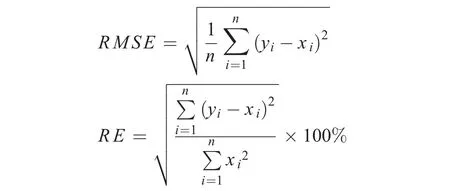
2 结果与分析
2.1根系特征参数值评估结果
图2为番茄移栽后第 16 天,对利用 GIARoot 系统得出的相关参数与破坏性取样利用 WinRHIZO Pro分析的根总长、根总表面积、根总体积、根平均直径数据进行比较的结果。发现各数据的线性回归斜率介于 0.9 6~0.9 9,R2均为 0.9 9,R E 为2.95%~12.69%。其中,根平均直径与其他三个根系特征参数相比 RE 较大,这可能是由于根平均直径均在 0.42~0.54 mm,数据较为集中,极小的误差也会造成统计学评估结果较差。另外,根系在营养液中由于浮力作用根系集中交错,造成数据分析具有部分误差,但是统计分析结果表明差异不显著(P<0.05),因此总体上 GIARoot 与 WinRHIZO Pro数据吻合较好,以上说明利用多视角成像系统和GIARoot 软件平台结合的多视角图像法分析根系生长发育准确可靠。
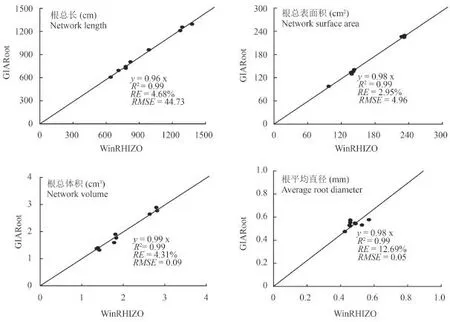
图2 GIARoot 与 WinRHIZO Pro 根总长、根总表面积、根总体积、根平均直径评估结果Fig.2 Assessment of the network length, network surface area, network volume and average root diameter for the GIARoot and WinRHIZO Pro
2.2不同氮水平对番茄幼苗根总长、根总表面积、根垂直投影面积、根总体积、根平均直径的影响
番茄幼苗不同氮水平下根总长、根总表面积、根垂直投影面积、根总体积参数值定植 16 d 内均以N12 最大(图3)。第 4 d,根总长、根总表面积、根垂直投影面积不同氮浓度间表现出显著性差异(P<0.05),N12 比 N20 分别显著高出 113.9%、153.7%、113.8%。第 12 d,根总体积在不同氮浓度间表现出显著性差异(P<0.05),N12 比 N20 显著高出57.0%。第 16 d,N12 的根总长、根总表面积、根垂直投影面积、根总体积分别比 N20 的显著高出54.6%、66.9%、34.9%、57.7%(P<0.05),N20 分别比 N4 高出 14.2%、13.2%、35.8%、27.7%。这说明在本试验条件下,高氮对以上 4 个根系特征增长具有抑制作用,且根总长、根总表面积、根垂直投影面积对氮素改变较为敏感。
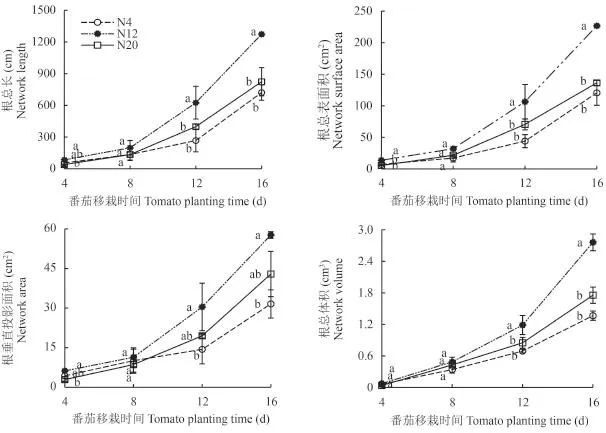
图3 番茄苗期不同氮水平根总长、根总表面积、根垂直投影面积、根总体积、根平均直径的动态变化Fig.3 Dynamic changes of the network length, network surface area, network area, network volume and average root diameter of tomato seedlings under different N treatments
而 16 d 内根平均直径 以 N12 最大、N4 最小,参数值在 0.42~0.54 mm(图4),不同氮浓度间无显著性差异,这与张蕊等[17]在施 N 0~200 kg/(hm2·a)下研究江西信丰木荷幼苗的结果基本一致。这说明在本试验条件下虽然高氮对根平均直径具有抑制作用,但对其无明显影响。
2.3不同氮水平对番茄幼苗根系侧根数量的影响
大部分研究认为,适当的硝酸盐浓度对根系生长具有促进作用,尤其是在低氮胁迫(0.01~1 mmol/L)下会促进侧根大量生成[11-12],这说明侧根数量对氮素改变极为敏感。一级侧根个数和横截面最大根个数这两个根系特征参数均能较好的反映根系侧根数量变化情况。
图5为番茄定植 16 d 内横截面最大根个数动态变化,不同时期在不同氮浓度间均以 N12 最高、N20 最低,且在第 12 d 不同氮浓度间就表现出显著性差异(P<0.05),N12 分别比 N4 和 N20 高 60.4%和 117.9%。表1为第 16 天番茄苗期一级侧根个数与横截面最大根个数,发现 N4 和 N12 的一级侧根个数分别比 N20 的高 30.4% 和 76.4%,横截面最大根个数分别比 N20 高 28.2% 和 74.1%。结合根总长、根总表面积、根垂直投影面积、根总体积、根平均直径数据,可以认为过高的氮浓度对番茄根系生长具有抑制作用,这种抑制在侧根数量上尤为明显。
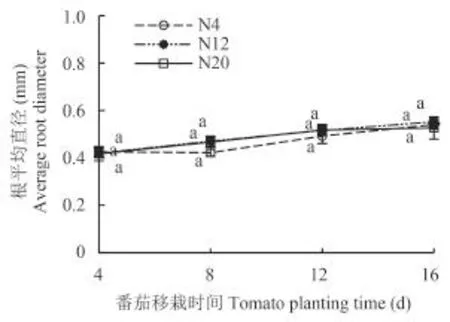
图4 番茄苗期不同氮水平根平均直径动态变化Fig.4 Dynamic changes of the average root diameters of tomato seedlings under different N treatments
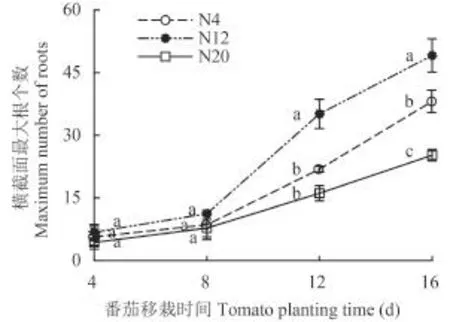
图5 番茄苗期不同氮水平横截面最大根个数动态变化Fig.5 Dynamic change of the maximum number of roots of tomato seedlings under different N treatments
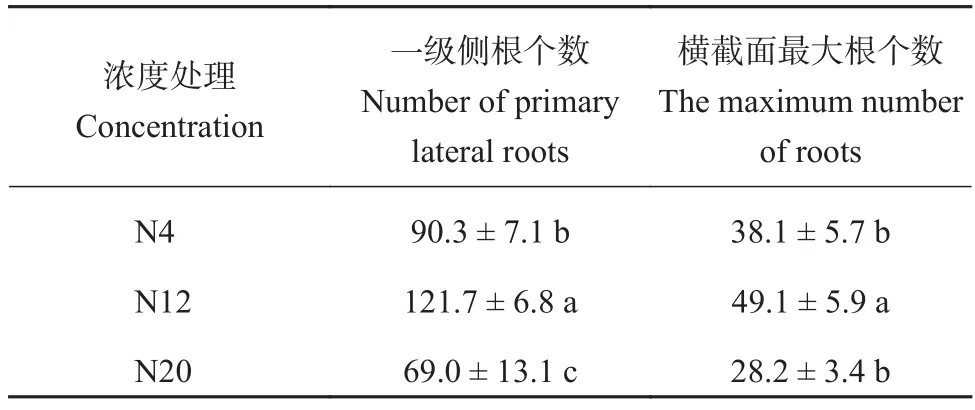
表1 番茄不同氮水平一级侧根个数与横截面最大根个数Table 1 Number of primary lateral roots and the maximum number of roots for tomato different N treatments
3 讨论与结论
传统根系研究方法如挖掘法、土钻法等大多具有破坏性,实际测量误差较大且测量时间多为根系发育后期[13,17]。即便采取不同发育期取样的研究方法也不是同一植株,个体差异较大,研究者只能通过增加工作量来降低误差[14-16]。本研究利用根系多视角成像系统和 GIARoot 软件分析平台能够无损、动态和定量分析根构型特征参数,为营养元素对根系表型影响机理研究提供强有力的手段和方法。
前人研究发现,氮素胁迫对植株根系根长、根表面积、根体积均有明显差异变化[13-16],但根系构型参数对不同氮浓度差异响应的时间未见报道。本研究利用根系多视角图像法无损和动态地观察及分析根构型对氮素浓度差异响应时间,发现不同氮素水平第 4 d 番茄幼苗根长、根表面积表现出显著性差异(P<0.05),第 12 d 根体积表现出显著性差异(P<0.05),这与传统方法取样时期有限相比,在获取数据的时效性和准确性上具有极大的优势。大部分研究表明,适量供氮对根系生长具有促进作用,过高氮浓度对根系生长有抑制作用[18-19]。本研究利用GIARoot 平台动态和定量分析结果表明,横截面最大根个数在第 12 d,N20 显著低于 N12(P<0.05)且与 N4 无显著差异;在第 16 d,N20 显著低于 N12 和N4(P<0.05);而 N20 根系根长、根表面积、根体积在第 16 d 显著低于 N12(P<0.05)且与 N4 无显著差异。以上结果表明,相对根长、根体积等特征参数,高氮对侧根生长的抑制作用更为明显,这可能是因为高浓度的硝酸根会通过阻碍侧根分裂组织的活性来抑制侧根的生长[20],且这种抑制作用只发生于刚刚从主根上发出的尚未成熟的侧根上,进而表现在侧根数量上的明显减少[21]。
本研究方法原理虽然适用于番茄等须根系无土栽培蔬菜作物,但本试验研究时间仅为根系较少的番茄苗期,若想研究多生育期,尤其是旺盛生长期的根系,可以使用尼龙网或塑料网将根系分层以便于根系分离。而对于玉米、水稻等大田作物,本试验研究方法不能获得有效的根宽、根深、根角度等三维根系特征参数信息,需要从栽培介质(琼脂等透明固体介质)等方面进行改进,研究基因型根构型差异[22]及理想根构型等特定构型育种[23]。另外,目前已有利用 RooTrak 分析 X-ray 扫描土壤获取的根系多角度 μCT 图像研究玉米根系构型,与传统的 X-ray分析方法相比精度显著提高[24]。
总之,本研究利用多视角图像法无损、动态分析根系形态,彻底改变了传统根系研究所用的破坏性测量和静态模式,对研究根构型与营养元素互相响应机理具有重要的指导意义。未来可利用多视角成像系统,基于根系三维分析平台进行原位无损定量三维根系,为研究矿质元素与根系三维构型的互作关系提供新的手段和依据。
[1]Gilbert G A, Knight J D, Vance C P, Allan D L. Proteoid root development of phosphorus deficient lupin is mimicked by auxin and phosphonate[J]. Annals of Botany, 2000, 85: 921-928.
[2]Lynch J P, Brown K M. Topsoil foraging: an architectural adaptation of plants to low phosphorus availability[J]. Plant and Soil, 2001, 237: 225-237.
[3]Warren J M, Hanson P J, Iversen C M, et al. Root structural and functional dynamics in terrestrial biosphere models-evaluation and recommendations[J]. New Phytologist, 2015, 205: 59-78.
[4]Jordan-Meille L, Pellerin S. Shoot and root growth of hydroponic maize(Zea mays L.)as influenced by K deficiency[J]. Plant and Soil,2008, 304: 157-168.
[5]Galkovskyi T, Mileyko Y, Bucksch A, et al. GiA Roots: software for the high throughput analysis of plant root system architecture[J]. BMC Plant Biology, 2012, 12: 1471-2229.
[6]Matlou M C, Haynes R J. Soluble organic matter and microbial biomass C and N in soils under pasture and arable management and the leaching of organic C/N and nitrate in a lysimeter study[J]. Applied Soil Ecology, 2006, 34: 160-167.
[7]赵营, 张学军, 罗健航, 等. 施肥对设施番茄-黄瓜养分利用与土壤氮素淋失的影响[J]. 植物营养与肥料学报, 2011, 17(2): 374-383. Zhao Y, Zhang X J, Luo J H, et al. Effect of fertilization on nitrogen leaching loss from soil and nutrients utilization by tomato and cucumber in greenhouse[J]. Plant Nutrition and Fertilizer Science,2011, 17(2): 374-383.
[8]孙治强, 李胜利, 张艳玲. 锯末基质中氮磷钾施用量与番茄幼苗生长的关系[J]. 华南农业大学学报(自然科学版), 2004, 25(1): 25-28. Sun Z Q, Li S L, Zhang Y L. Relationship between N, P and K application and the growth of tomato seedling sowed in the sawdustrich substrates[J]. Journal of South China Agricultural University(Natural Science Edition), 2004, 25(1): 25-28.
[9]Evanylo G, Sherony C, Spargo J, et a1. Soil and water environmental effects of fertilizer, manure, and compost-based fertility practices in an organic vegetable croping system[J]. Agriculture Ecosystems and Environment, 2008, 127: 50-58.
[10]Leitner D, Klepsch S, Bodner G, Schnepf A. A dynamic root system growth model based on L-Systems[J]. Plant and Soil, 2010,332:177-192.
[11]Hackett C. A method of applying nutrients locally to roots under controlled conditions, and some morphological effects of locally applied nitrate on the branching of wheat roots[J]. Australian Journal of Biological Sciences, 1972, 25: 1169-1180.
[12]Drew M C. Comparison of the effects of a localized supply of phosphate, nitrate, ammonium and potassium on the growth of the seminal root system, and the shoot, in barley[J]. New Phytologist,1975, 75: 479-490.
[13]乔海涛, 杨洪强, 申为宝, 等. 缺氮和缺铁对平邑甜茶幼苗根系构型的影响[J]. 园艺学报, 2009, 36(3): 321-325. Qiao H T, Yang H Q, Shen W B, et al. Effect of nitrogen-deficient and iron-deficient on root architecture of young seedlings of Malus hupehensis(Pamp)rehd[J]. Acta Horticulturae Sinica, 2009, 36(3): 321-325.
[14]王树起, 韩晓增, 乔云发, 等. 施氮对大豆根系形态和氮素吸收积累的影响[J]. 中国生态农业学报, 2009, 17(6): 1069-1073. Wang S Q, Han X Z, Qiao Y F, et al. Root morphology and nitrogen accumulation in soybean(Glycine max L.)under different nitrogen application levels[J]. Chinese Journal of Eco-Agriculture, 2009,17(6): 1069-1073.
[15]李灵芝, 郭荣, 李海平, 曹阳. 不同氮浓度对温室番茄生长发育和叶片光谱特性的影响[J]. 植物营养与肥料学报, 2010, 16(4): 965-969. Li L Z, Guo R, Li H P, Cao Y. Effects of nitrogen concentration in hydroponics on growth and development of tomato and spectral characteristics of leaf in greenhouse[J]. Plant Nutrition and Fertilizer Science, 2010, 16(4): 965-969.
[16]孙日波, 赵从凯, 张玲, 赵兰勇. 氮磷钾营养亏缺对玫瑰幼苗根构型的影响[J]. 中国土壤与肥料, 2013,(3): 43-48. Sun R B, Zhao C K, Zhang L, Zhao L Y. Effect of N, P, K-deficiency on root architecture of young seedings of Rosa Rugosa[J]. Soils and Fertilizers Sciences in China, 2013,(3): 43-48.
[17]张蕊, 王艺, 金国庆, 等. 施氮对木荷 3 个种源幼苗根系发育和氮磷效率的影响[J]. 生态学报, 2013, 33(12): 3611-3621. Zhang R, Wang Y, Jin G Q, et al. Nitrogen addition affects root growth, phosphorus and nitrogen efficiency of three provenances of Schima superba in barren soil[J]. Acta Ecologica Sinica, 2013, 33(12): 3611-3621.
[18]黄高宝, 张恩和, 胡恒觉. 不同玉米品种氮素营养效率差异的生态生理机制[J]. 植物营养与肥料学报, 2001, 7(3): 293-297. Hang G B, Zhang E H, Hu H J. Eco-physiological mechanism on nitrogen use efficiency difference of corn varieties[J]. Plant Nutrition and Fertilizer Science, 2001, 7(3): 293-297.
[19]Forde B, Lorenzo H. The nutritional control of root development[J]. Plant and Soil, 2001, 232: 51-68.
[20]Zhang H and Forde B G. An Arabidopsis MADS box gene that controls nutrient-induced changes in root architecture[J]. Science,1998, 279: 407-409.
[21]Zhang H, Jennings A, Peter W B, et a1. Dual pathways for regulation of root branching by nitrate[J]. Plant and Biology, 1999, 96: 6529-6534.
[22]Clark R T, MacCurdy R B, Jung J K, et al. Three-dimensional root phenotyping with a novel imaging and software platform[J]. Plant Physiology, 2011, 156: 455-465.
[23]Fang S Q, Clark R T, Zheng Y, et al. Genotypic recognition and spatial responses by rice roots[J]. Proceedings of the National Academy of Sciences of the United States of America, 2013, 110: 2670-2675.
[24]Lynch J P, Brown K M. Topsoil foraging: an architectural adaptation of plants to low phosphorus availability[J]. Plant and Soil, 2001, 237: 225-237.
Analysis of nitrogen effects on root system architecture of tomato seedlings using the multi-view images method
HUI Fang1,MA Yun-tao1,ZHU Jin-yu2*,JIANG Wei-jie2
(1 College of Resources and Environmental Sciences, China Agricultural University, Beijing 100193, China;2 Institute of Vegetables and Flowers, Chinese Academy of Agricultural Sciences, Beijing 100081, China)
【Objectives】Root is an important plant organ of obtaining nutrient from soil. Therefore, how to obtain root parameter values nondestructively and efficiently is a current research hotspot. With the rapid development of high-throughput imaging technology, nondestructive measurement based on multi-view imageshas become a new method to study root system architecture. In this study, precision of the root multi-view imaging system combined with GIARoot parameter analysis platform was accurately assessed. Then, effects of different N levels on root system architecture of tomato seedlings were analyzed dynamically and quantitatively. This multi-view imaging system can provide the basis for further study on the interaction of root system architecture and mineral elements.【Methods】Three N treatments were designed in the experiment, namely, N concentrations of 4, 12 and 20 mmol/L, indicating as N4, N12 and N20. Under the hydroponic condition,“Zhong Za 109” tomato seedlings were planted for 16 days in transparent glass column. The self-designed root multi-view imaging system was used to obtain daily image sequences around the growing root system. Then,root characteristic parameters along the plant growth were quantitative calculated with the GIARoot platform according to the photographed root system nondestructively. At the final measurement(16 d after the planting),destructive measurements were done on root system and analyzed with WinRHIZO Pro software, and the results were compared with GIARoot plantform.【Results】There were no significant differences on each root characteristic parameter between the GIARoot and WinRHIZO Pro(P>0.05). The slopes of the linear regression between the parameters using the two methods were between 0.96 and 0.99, and values of R2were all 0.99 and REs ranged from 2.95% to 12.69%. The RMSEs of network length, network surface area, network volume and average root diameter were 44.73 cm, 4.96 cm2, 0.09 cm3and 0.05 mm, respectively. Each root characteristic parameter of the N12 was the largest on the16th day among the treatments of N4, N12 and N20. The network length, network surface area, network area and network volume of the N20 were 14.2%, 13.2%, 35.8% and 27.7%, respectively, higher than those of the N4. However, the maximum number of roots and the number of primary lateral roots of the N4 were 28.2% and 30.4% higher than the N20, respectively. In addition, significant differences were found on the network length, network surface area and network area between the three N treatments on the 4th day(P<0.05), and the values of them of the N12 were 113.9%, 153.7% and 113.8% higher than the N20, respectively. Meanwhile, significant differences were found on the network volume and the maximum number of roots between the three N treatments on the 12th day(P<0.05), and the values of the N12 were 57.0% and 117.9% higher than the N20, respectively. However, there were no significant differences on the average root diameter on the 16th day(P>0.05)and all of them were between 0.42 and 0.54 mm.【Conclusions】The multi-view images method combining the root multi-view imaging system with GIARoot platform, can nondestructively obtain the root characteristic parameters. The N effects on the root architecture characteristics showed that increasing N concentration within certain range could promote root growth of tomato seedlings. However, the N concentration of 20 mmol/L had an inhibition on tomato seedling root growth, particularly on the number of lateral roots, and N concentration had the least influence on the growth of root diameter.
tomato seedling; nitrogen; root characteristic parameters; GIARoot; nondestructive measurement
S126
A
1008-505X(2016)05-1418-07
2015-08-07接受日期:2016-01-18
日期:2016-05-26
国家自然科学基金项目(31301816);中国农业大学教育基金会“大北农教育基金”项目;农业部园艺作物生物学与种质创制重点实验室项目资助。
惠放(1992—),女,辽宁锦州人,博士研究生,主要从事根系与营养元素互作的模型研究。
E-mail:fanghui6728@gmail.com。* 通信作者 E-mail:zhujinyu@caas.cn
